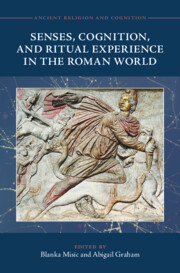Book contents
- Senses, Cognition, and Ritual Experience in the Roman World
- Ancient Religion and Cognition
- Senses, Cognition, and Ritual Experience in the Roman World
- Copyright page
- Contents
- Figures
- Contributors
- Acknowledgements
- Abbreviations
- Introduction Experiencing Rituals
- Chapter 1 Remembering the Rites: Religious Learning Network Model and Transmission of Religious Rituals in the Worship of Nutrices Augustae (Poetovio, Pannonia Superior)
- Chapter 2 The Haptic Production of Religious Knowledge among the Vestal Virgins: A Hands-On Approach to Roman Ritual
- Chapter 3 Haptic Colour: Experiential Viewing in Graeco-Roman Sacred Spaces
- Chapter 4 Nobody Is Gonna Rain on My Parade: Experiencing Salutaris’s Procession As a Ritual Event
- Chapter 5 Objects and Ritual in Egeria’s Fourth-Century Pilgrimage: The Props of My Faith
- Conclusion (Re)Creating Ritual Experiences
- Index
- References
Chapter 2 - The Haptic Production of Religious Knowledge among the Vestal Virgins: A Hands-On Approach to Roman Ritual
Published online by Cambridge University Press: 04 January 2024
- Senses, Cognition, and Ritual Experience in the Roman World
- Ancient Religion and Cognition
- Senses, Cognition, and Ritual Experience in the Roman World
- Copyright page
- Contents
- Figures
- Contributors
- Acknowledgements
- Abbreviations
- Introduction Experiencing Rituals
- Chapter 1 Remembering the Rites: Religious Learning Network Model and Transmission of Religious Rituals in the Worship of Nutrices Augustae (Poetovio, Pannonia Superior)
- Chapter 2 The Haptic Production of Religious Knowledge among the Vestal Virgins: A Hands-On Approach to Roman Ritual
- Chapter 3 Haptic Colour: Experiential Viewing in Graeco-Roman Sacred Spaces
- Chapter 4 Nobody Is Gonna Rain on My Parade: Experiencing Salutaris’s Procession As a Ritual Event
- Chapter 5 Objects and Ritual in Egeria’s Fourth-Century Pilgrimage: The Props of My Faith
- Conclusion (Re)Creating Ritual Experiences
- Index
- References
Summary
This chapter brings the sensory potentialities of material objects used in Roman ritualized activities into discourse concerning the nature and production of ancient religious knowledge. By combining perspectives derived from lived religion and material religion it is argued that religious agency should be understood as the product of the intertwining of human and more-than-human things within assemblages. Lived experiences of this production of agency, in turn, cause people to feel and consequently think in certain ways, ultimately producing what can be categorized as distal and proximal forms of religious knowledge. The chapter uses the example of the frieze of the Vestal Virgins from the Ara Pacis Augustae to argue that different forms of ancient religious knowledge were actively created through a multiplicity of lived experiences of ritualized action that brought human and more-than-human material things together, rather than existing only as something that was expressed through ritual behaviours. Exploring the Vestals’ experience of ritualized encounters with material things makes it possible to establish new understandings of the real-world lived experiences and identities of these priestesses, offering significant insights into how individualized forms of religious knowledge could be sustained even in the context of shared communal or public rituals.
Keywords
- Type
- Chapter
- Information
- Publisher: Cambridge University PressPrint publication year: 2024



